Malmö FF are one of the biggest sides in Scandi football. In 2021, they were quite successful as they entered the UEFA Champions League group stage, competed with Juventus, Chelsea, and Zenit. Meanwhile, they also won the gold in Allsvenskan, securing a back-to-back title over competitors such as AIK, Elfsborg, and Djurgården.
However, after the season, Jon Dahl Tomasson departed, and Malmö could not retain Antonio Čolak and Anel Ahmedhodžić. Hence, a head coach and a striker were needed, and now we had the answers. Again, Isaac Kiese Thelin returned, this was the third time for the former Bayer Leverkusen man to join Malmö. They also appointed Miloš Milojević, who parted way with Hammarby in December, as the head coach.
Malmö were already successful last season, it was difficult to build on more from it, but that is Miloš’ task. This tactical analysis will examine how Miloš tested his side in the Svenska Cupen with a 4-3-3, and the tactical philosophy behind that beat AIK and Djurgården on the road.
Rakip’s role in the construction
Malmö had so many talents and established players, Kiese Thelin was one of them, they also had experienced international players such as Anders Christiansen, Niklas Moisander, and Martin Olsson. However, the 26-year-old Erdal Rakip emerged as the 6 of the team, who looked promising on Miloš’s side so far. He only had 15 starts in the last All Swedish Football campaign, and he really stepped up to be a vital part of the team.
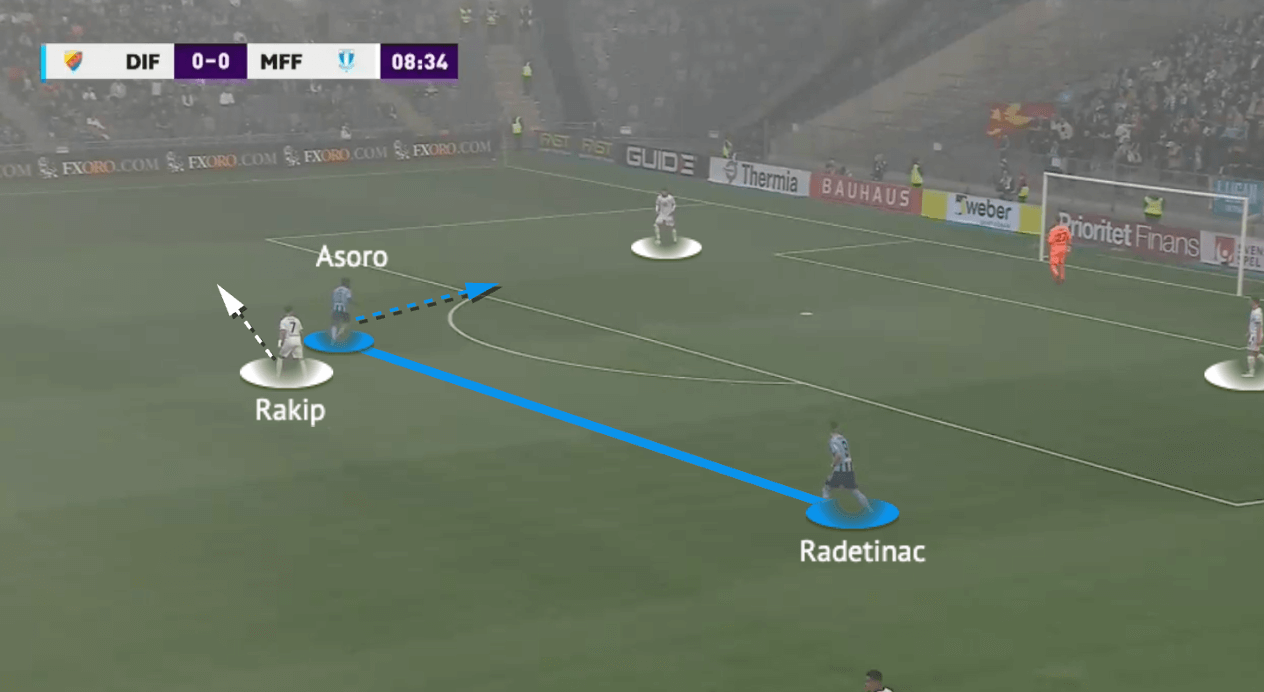
In the build-up, although Malmö also used a pair of wide full-backs, the 6 was still required to provide a passing option for the centre-backs. In this sense, Rakip was good at moving in spaces to help his teammates, including in this example, when Joel Asoro pressed the centre-back, Rakip moved on the blindside to give Lasse Nielsen a vertical option.
This was also a 3v2 when Djurgården pressed in a 4-4-2, as Victor Edvardsen was deeper in their system. Since the centre-backs split, Haris Radetinac could not close Rakip when he was with Moisander initially.
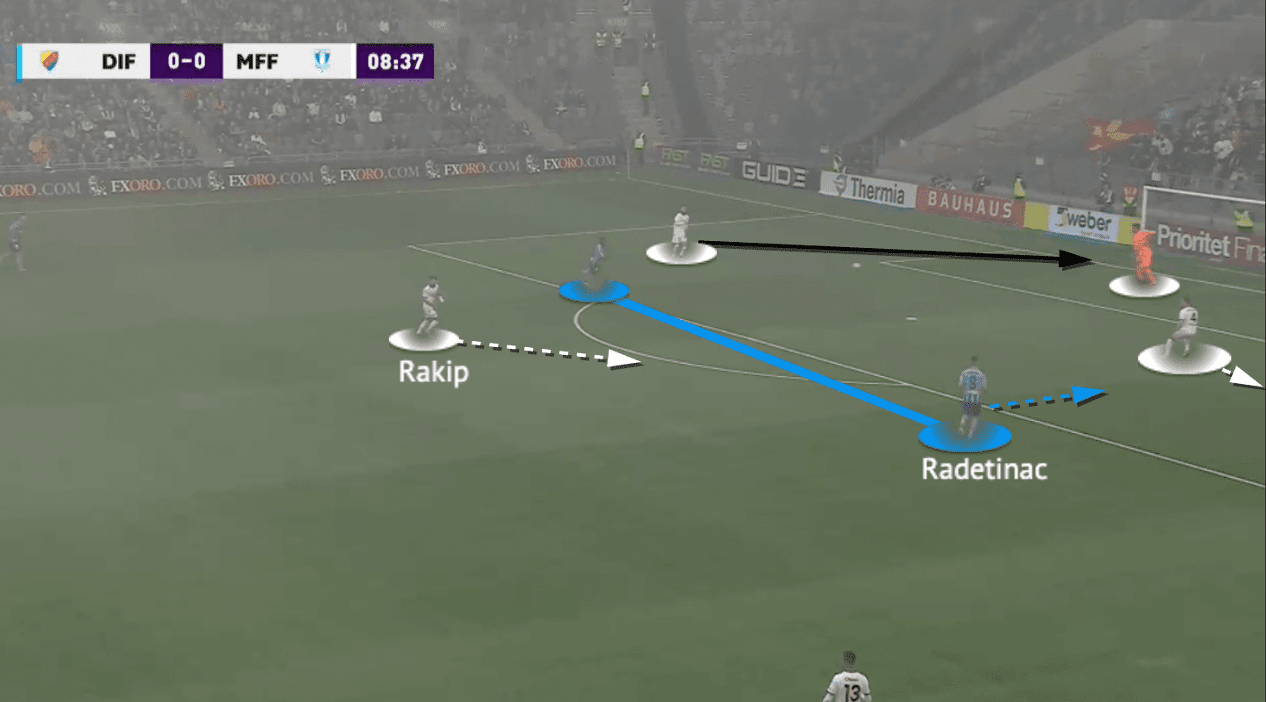
But Nielsen did not make the pass to Rakip in the previous scene, he moved the ball back to Johan Dahlin, and now we see the Malmö 6 was helping again. Here, Moisander moved wider to create enough width to stretch the two-man first line of Djurgården, attracting Radetinac.
Meanwhile, when Asoro went for Nielsen and then pressed Dahlin, he could not close the angle to Rakip. The 26-year-old midfielder was good at moving behind the lines to open options for teammates, so it was possible if Dahlin played in the centre after receiving Nielsen’s pass.
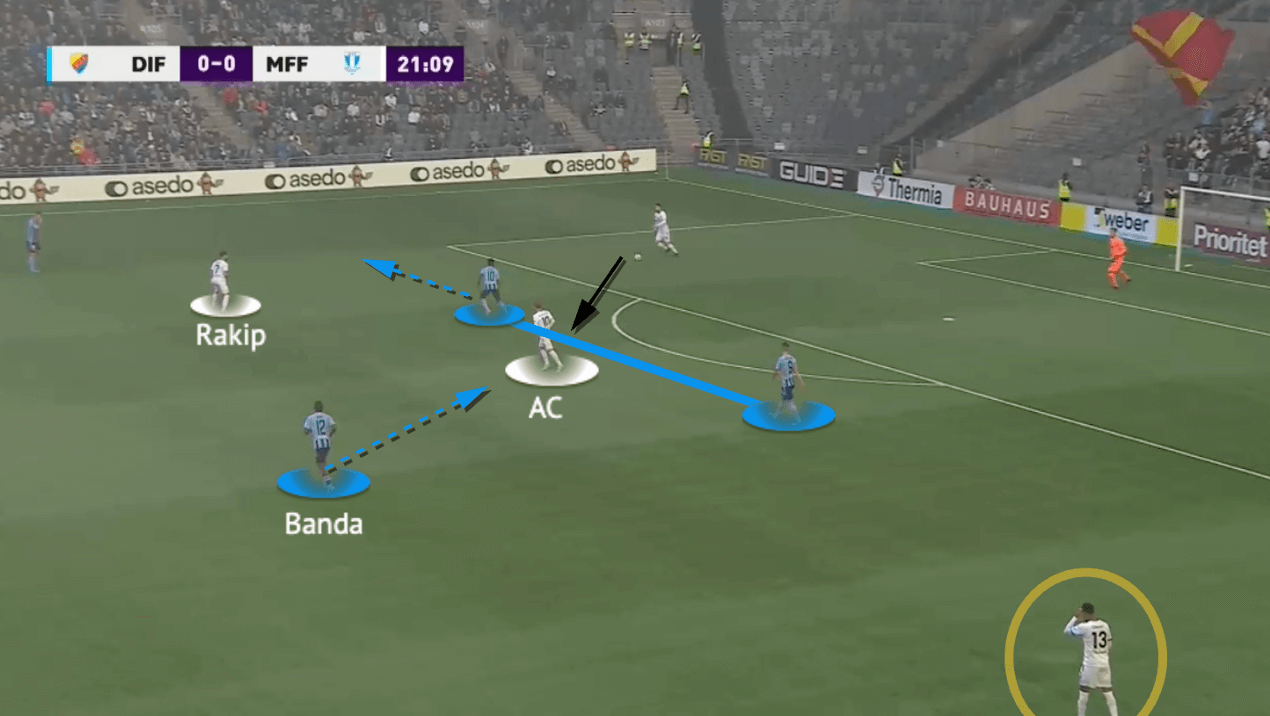
So far, Malmö’s 4-3-3 midfield consisted a 6, that was Rakip. For another two midfielders, one of them would be functioning between an 8 and a 6, which means he would be able to stay higher while dropping to help when required. Sergio Peña and Christiansen were these sorts of players. The last midfield would be a player comfortable in spaces, having the technique to play, receive, and turn between the lines, and supporting the striker in the penalty box like Sebastian Nanasi.
Back to the construction phase of Malmö, since they could add a player dropping, that also means Rakip could be a decoy only. On most occasions, Rakip would end up in a vertical position to support the centre-back with the ball, that would open up the angle for the dropping player to receive.
Here, as Asoro wanted to close Rakip, he exposed the central passing lane to Christiansen, so Djurgården must use Banda to close him, but if the opponent committed another midfielder to press, the Malmö full-back, Olsson, would be without marking.
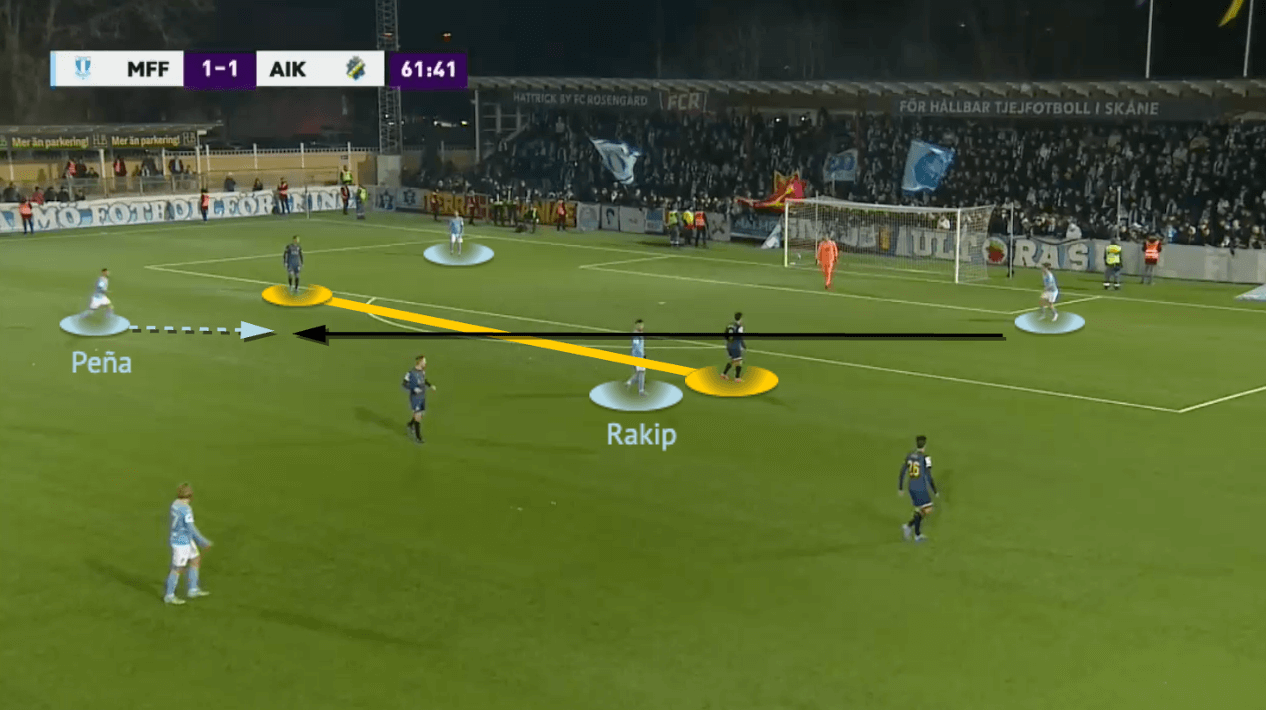
Again, we can see a similar situation in this example with AIK. This time, Moisander was on the ball and Rakip gave him a vertical option. It kept the AIK striker (Nicolás Stefanelli) in the half-space to block the Malmö 6, with Nielsen stretching Nabil Bahoui wide on the other side.
As a result, Peña could freely drop into spaces inside to receive, turn, and progress the attack to higher spaces. Rakip might not touch the ball in the whole process, but he could impact the game with his movements, which was important.
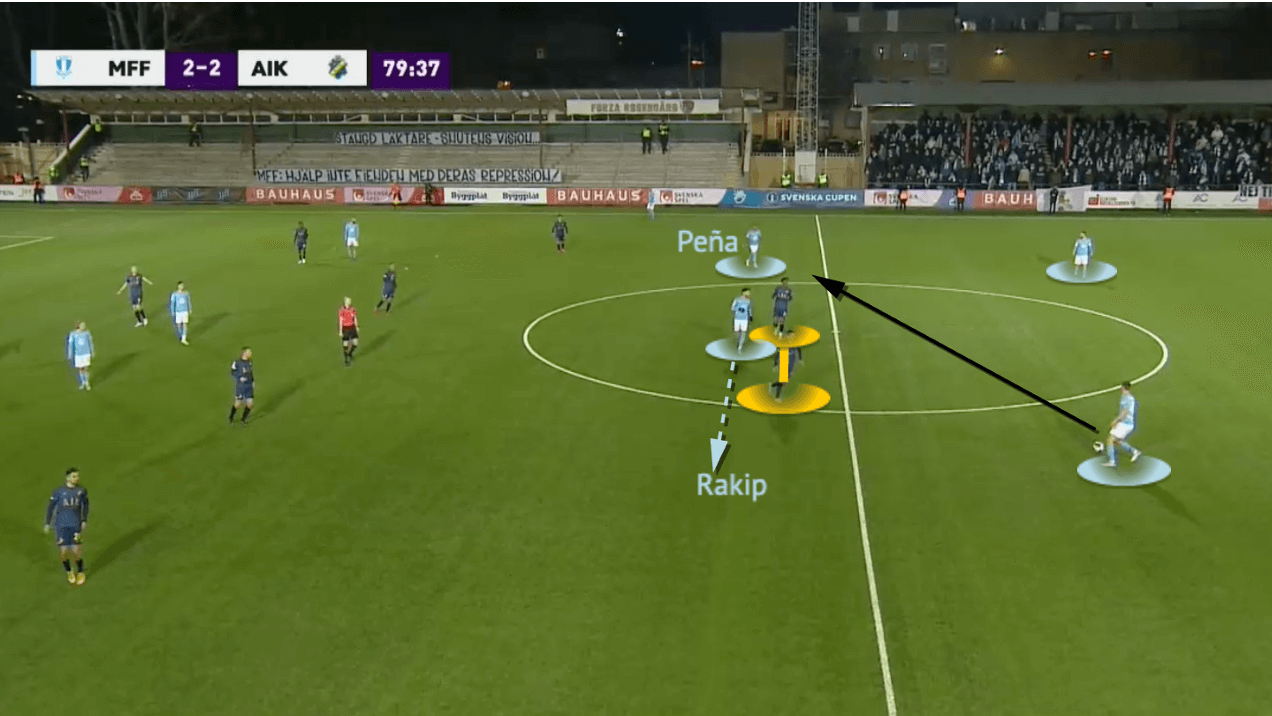
In the middle third, Rakip also used his movements and positionings to create the condition for the 8 to receive. Against AIK’s 4-4-2, he moved to the left side to give Moisander a vertical option, which brought the striker as well. As a result, Peña dropped to receive the diagonal on the other side, Malmö could develop the attack there.
Final third, rest defence, TAD
Malmö were usually the dominant side of the game, part of the reason was everyone knew that they were the biggest in Sweden, and mentally that was a boost. The tactical reason was the vertical and intense plays would make the opponents tired, which we would explain in this section of the analysis.
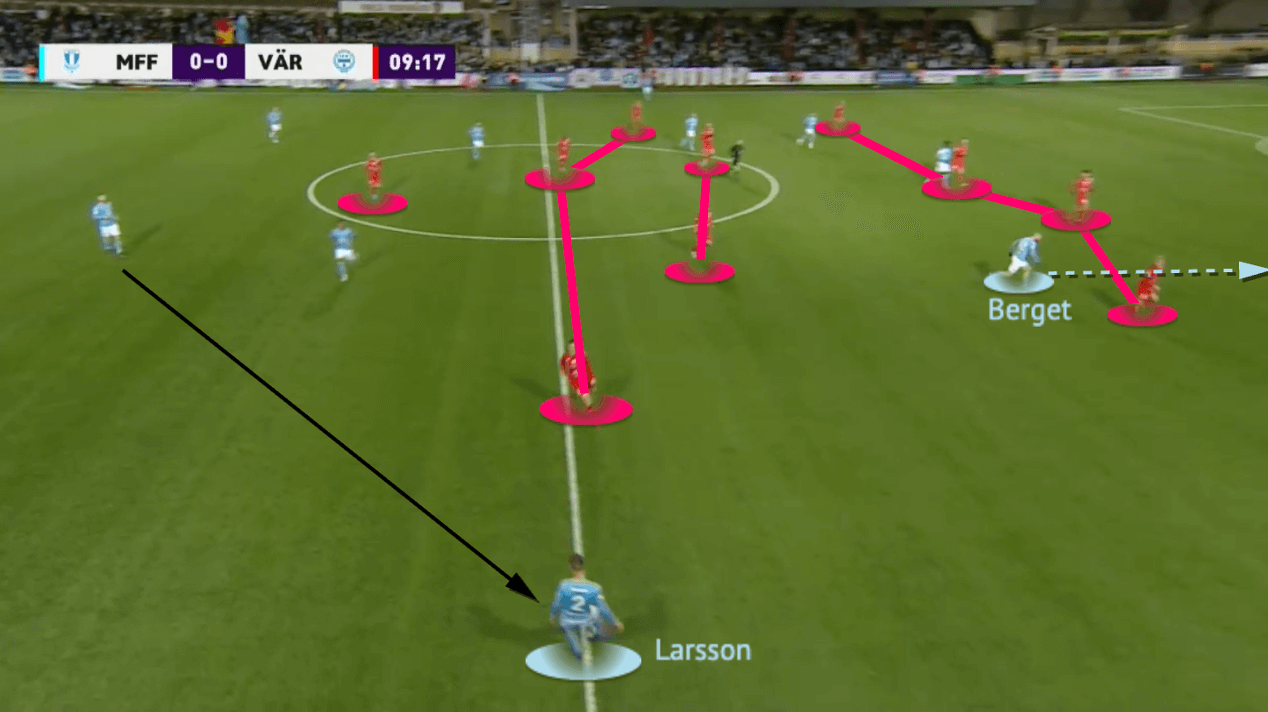
When the Malmö full-back is going to receive the ball, the winger or attacking players would always make a run in behind the last line, which opened an option in depth while it also push the defence deeper, creating more spaces to play in the midfield.
For example, here, when Eric Larsson was going to receive, Jo Inge Berget ran behind so the left-back could not press E. Larsson.
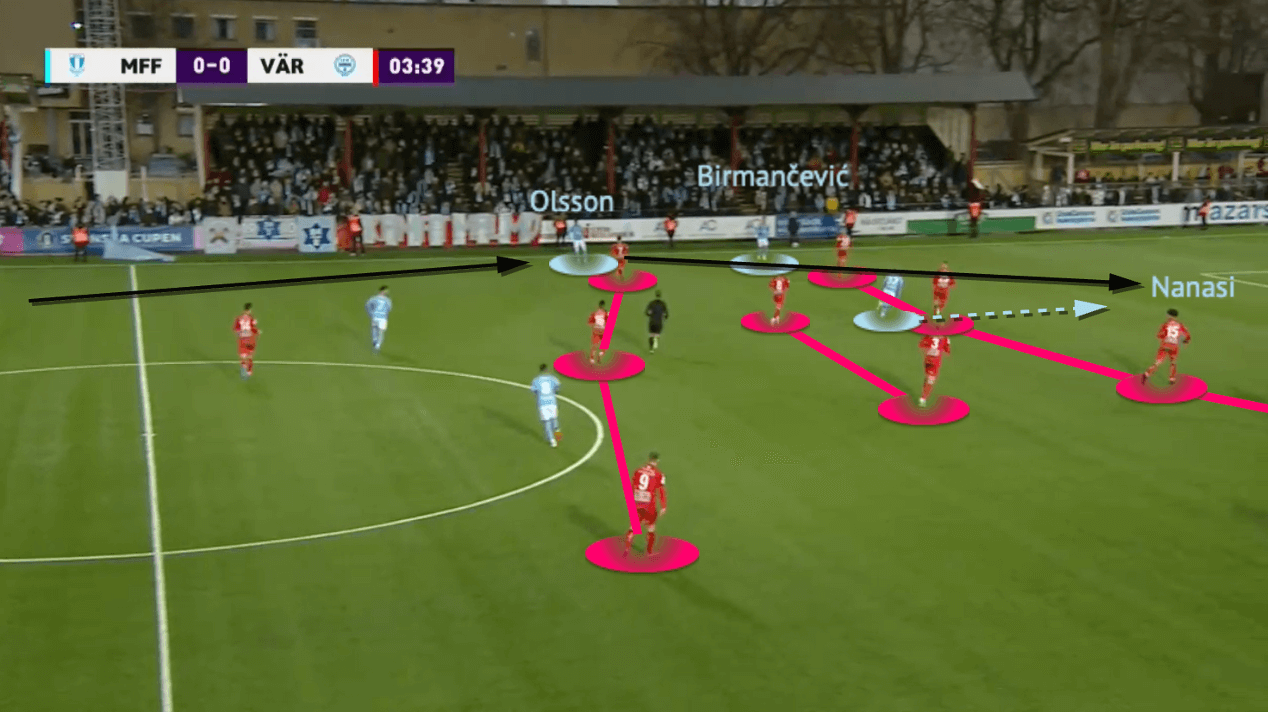
If possible, the Malmö full-back would hit the ball to the runner in spaces behind, this is their quickest way to reach the final third without too much speculation. In the above image, they used this pattern although it was not the winger who made the run.
Instead, when Olsson received, Veljko Birmančević was also wide, he pulled the Värnamo right-back wide to open the half-spaces channel. This time, Nanasi ran behind and he was picked by Olsson’s pass very simply.
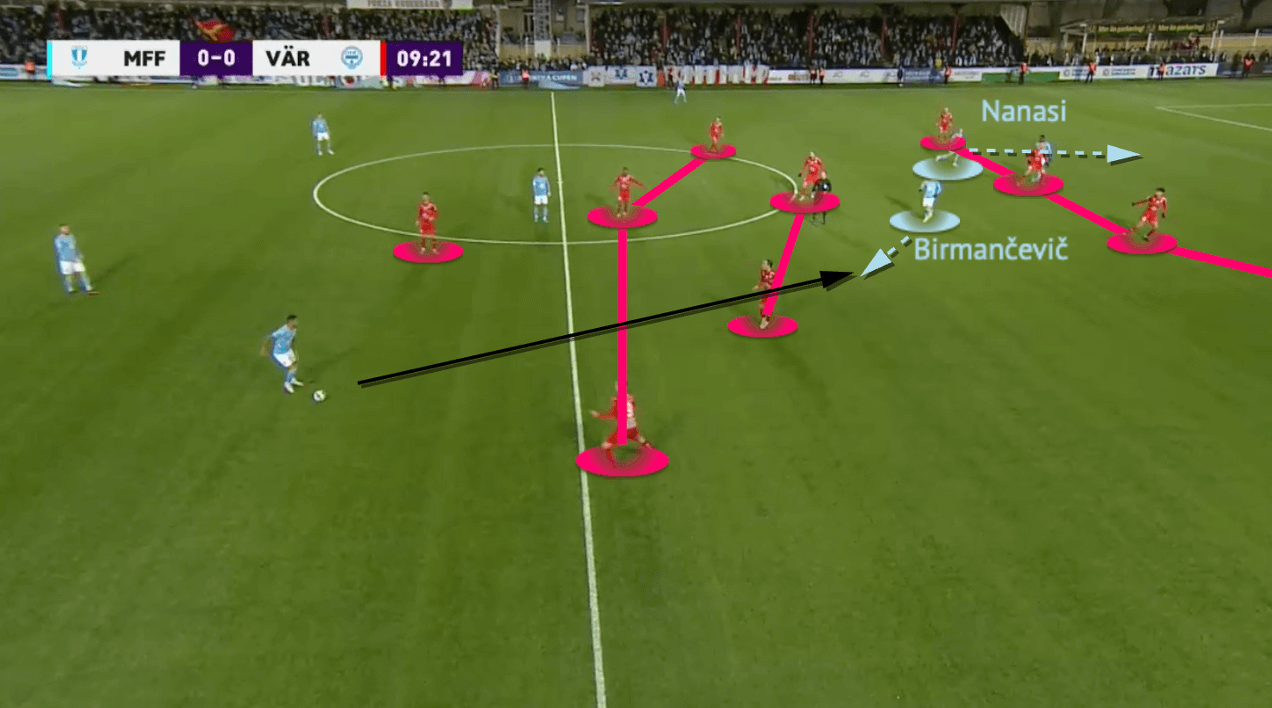
Sometimes the Malmö wingers were not going behind, but then they rarely stayed on the touchline, because Birmančević could also play in the centre. Instead, he did that a lot to take the spaces, allowing the 8 to drop in the construction as we have explained, which would open options for the team in between the lines.
Here, Peña was deep to operate, and Birmančević roamed from the left side to receive behind the Värnamo midfield. It would be even more complicated and difficult for the centre-backs to step up when there was a runner behind, which was Nanasi in this example.
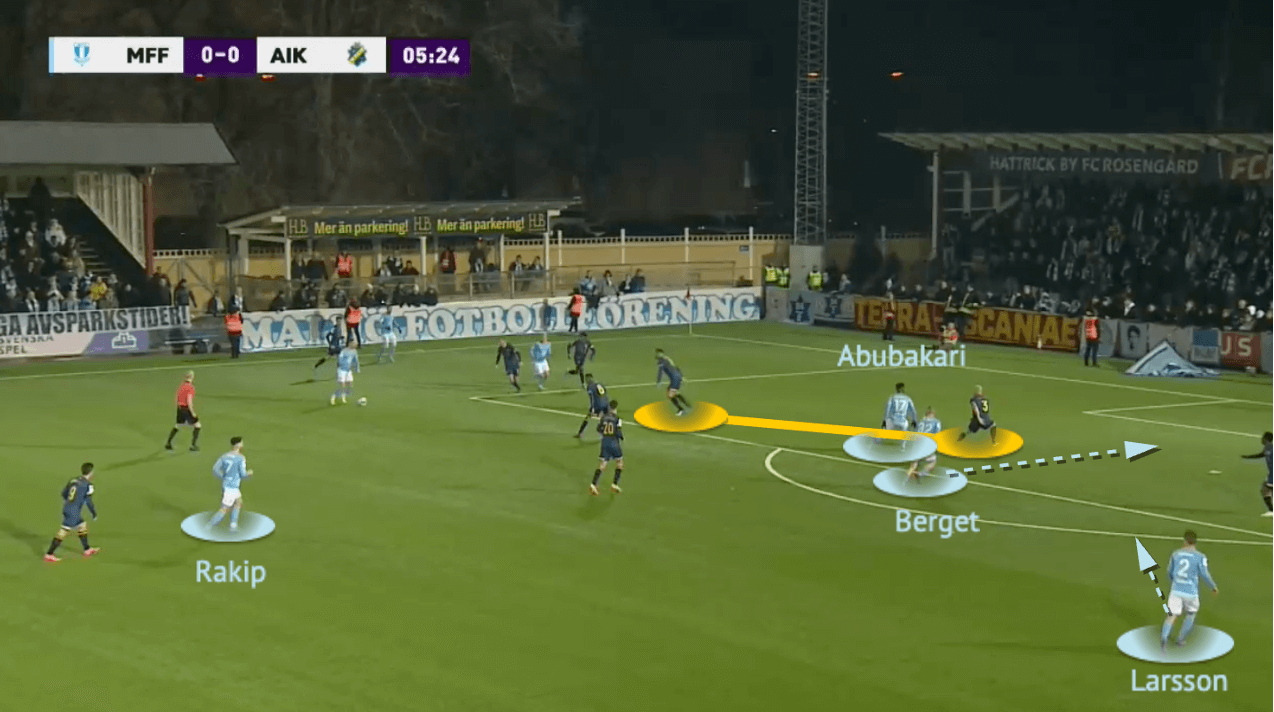
Because of the winger’s inside position, they were also the early threat in the final third. By contrast, if they stayed very wide, they were away from the goal. Malmö were good at crossing at different timing, there were deep crosses, early crosses, and crosses with players from different feet, when the opponents were defending in a block, they could suddenly put the ball in and you have to defend.
Here, the striker was Malik Abubakari, and the other player who made the deep run was Berget, the right-winger. Because of the starting position was inside, and the run was deep, he could be an instant target for the cross in the penalty box.
Meanwhile, we also see E. Larsson and Rakip in this image, the full-back would take up a relatively inside position to form the rest defence with the 6, so they could counter-press or pick up the second ball chances to shoot if the first cross was cleared by the defender.
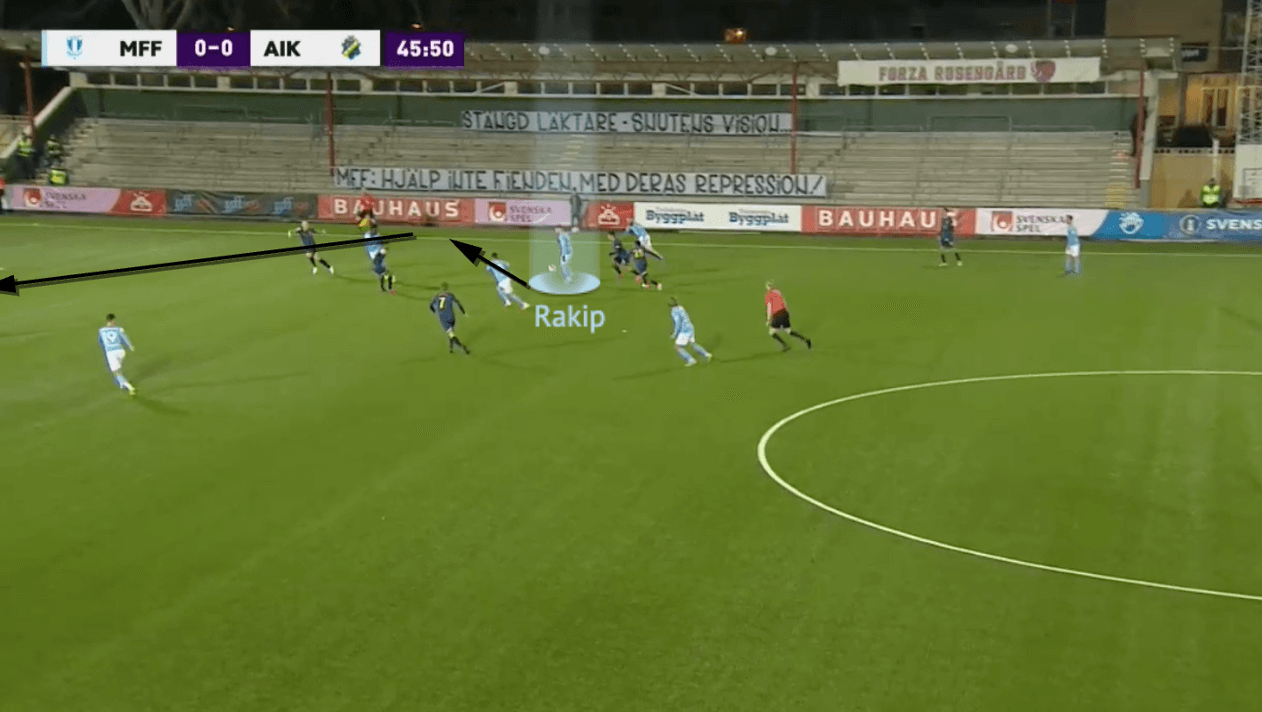
Malmö’s 6, Rakip, was very important and almost undroppable because he helped the team to kill the TAD. Only reading the game was not enough, as that position of Miloš must also possess the capacity to run across the pitch. Here, we see a good example of Rakip, where Malmö developed the attack on the right side and crossed on the right side.
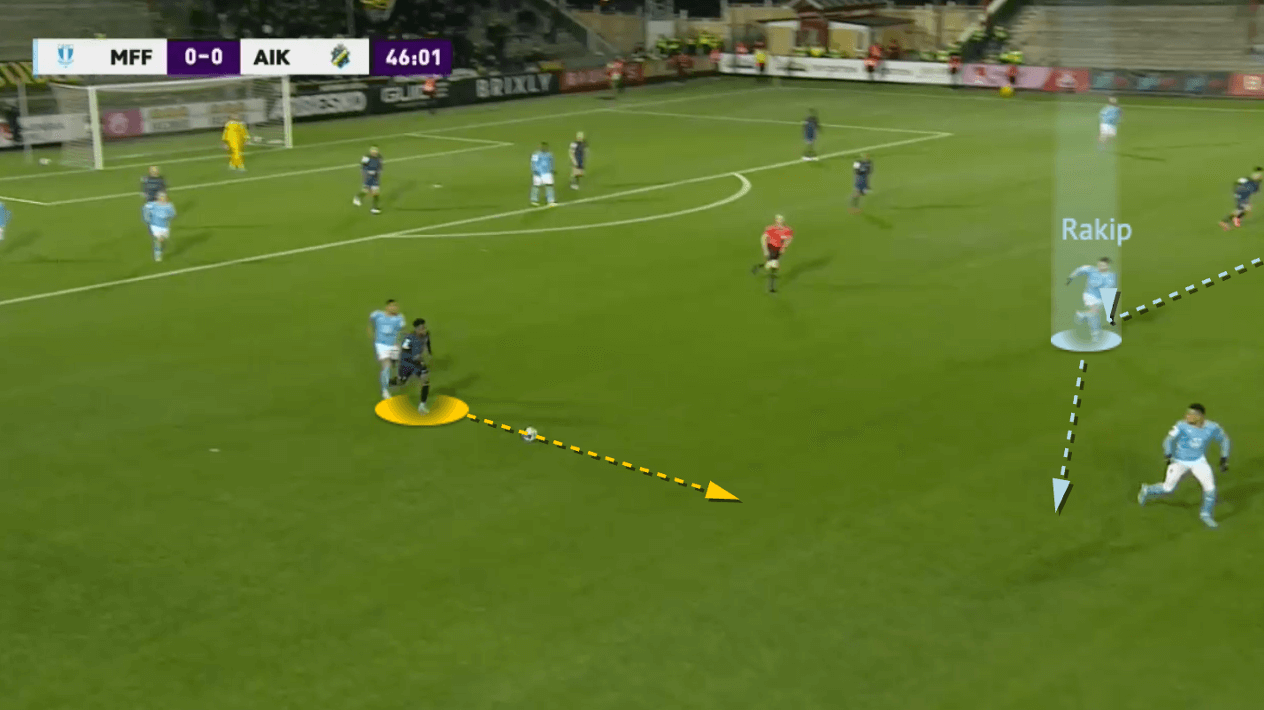
The cross was not successful, and now AIK had a chance to counter with Josafat Mendes carrying the ball forward. Now you see Rakip was arriving from the other side of the pitch to stop him, but he did not engage early because Mendes was charging at a great speed.
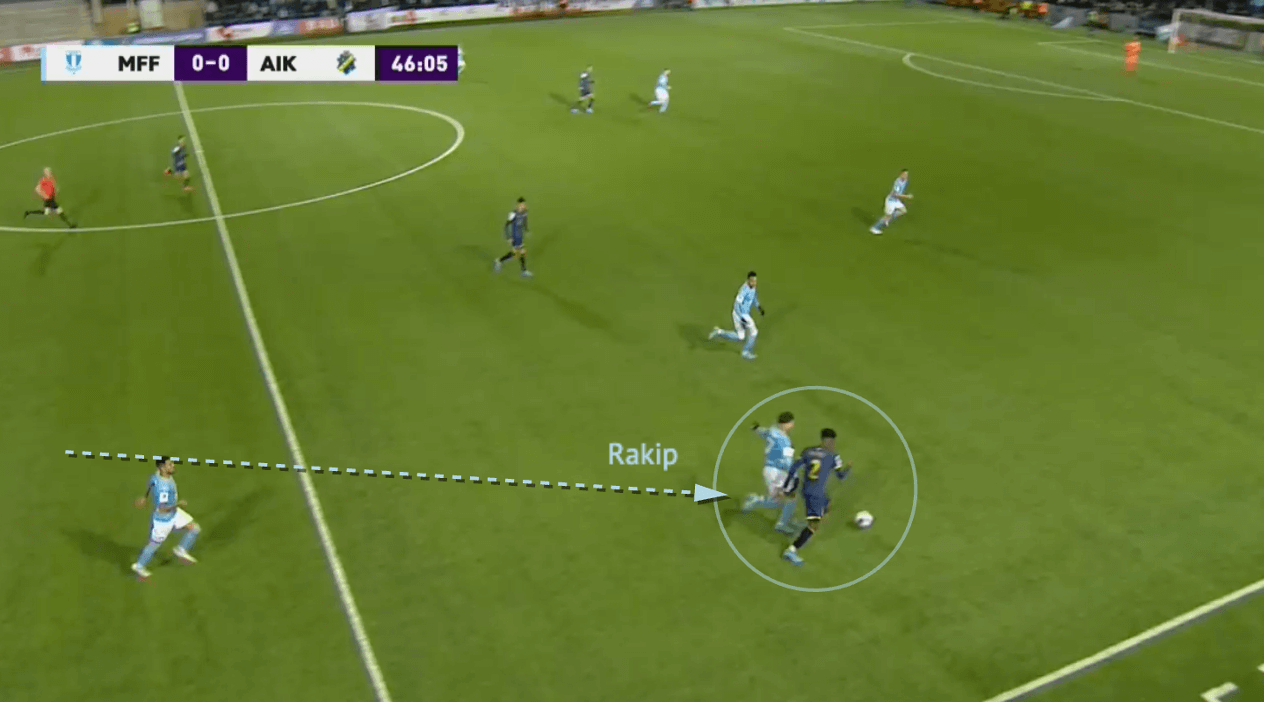
Rakip just ran with Mendes backed to his own half, and he did not challenge either. It was important to be patient and not committing, because if the angle of the challenge was not right, the opponent could escape very easily and that was especially risky in transitions. For example, if Rakip was beaten here, it was a 3v3 for AIK, and they also had an extra man running in the central circle now, which could be dangerous.
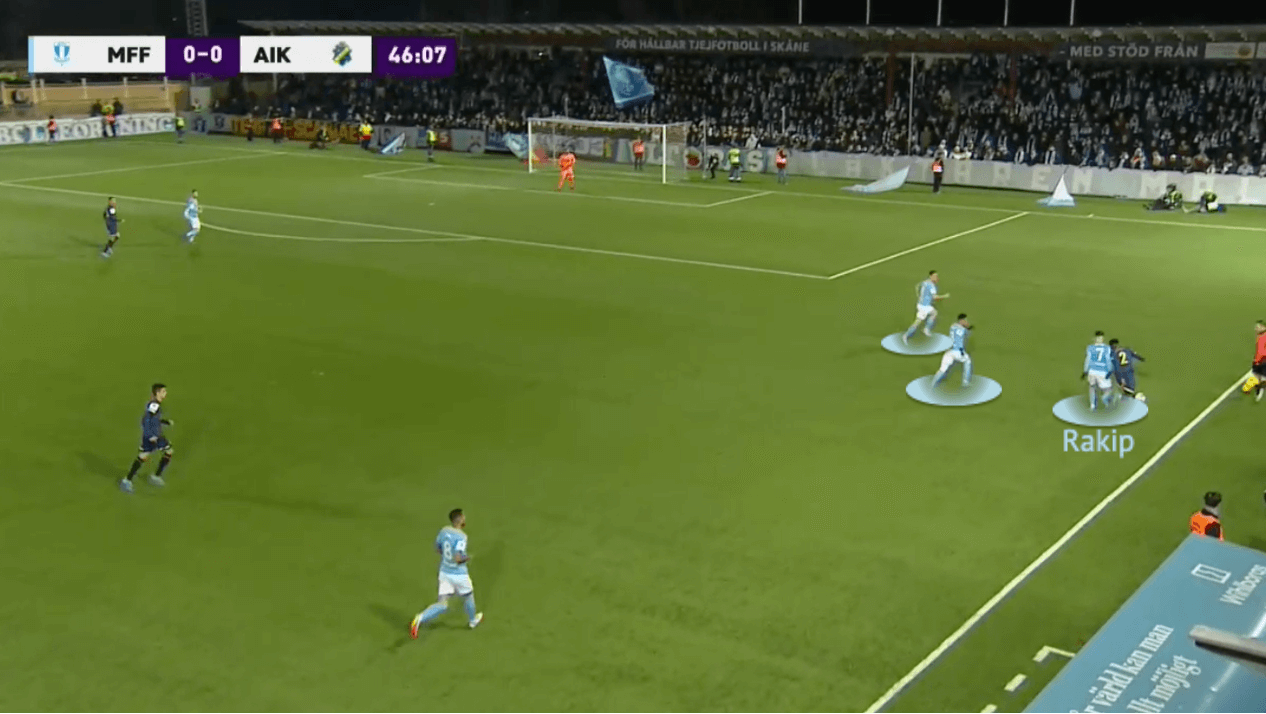
But because of Rakip’s good work, he turned the potential danger to a safe situation, from the 3v3 to a 3v1. Without challenging too early, Mendes was guided to the flank by Rakip, and the other two Malmö players could now press together, nothing could happen here thanks to the 6’s good protection in transitions.
High pressing
Miloš’ side was also known for intense pressing, that was how his Hammarby played. At Malmö, they did not do that high pressing throughout 90 minutes, because the Svenska Cupen was in the preseason, the condition of the team might not be ready yet. But when they pressed high, there were also good tactics and intensity behind them.
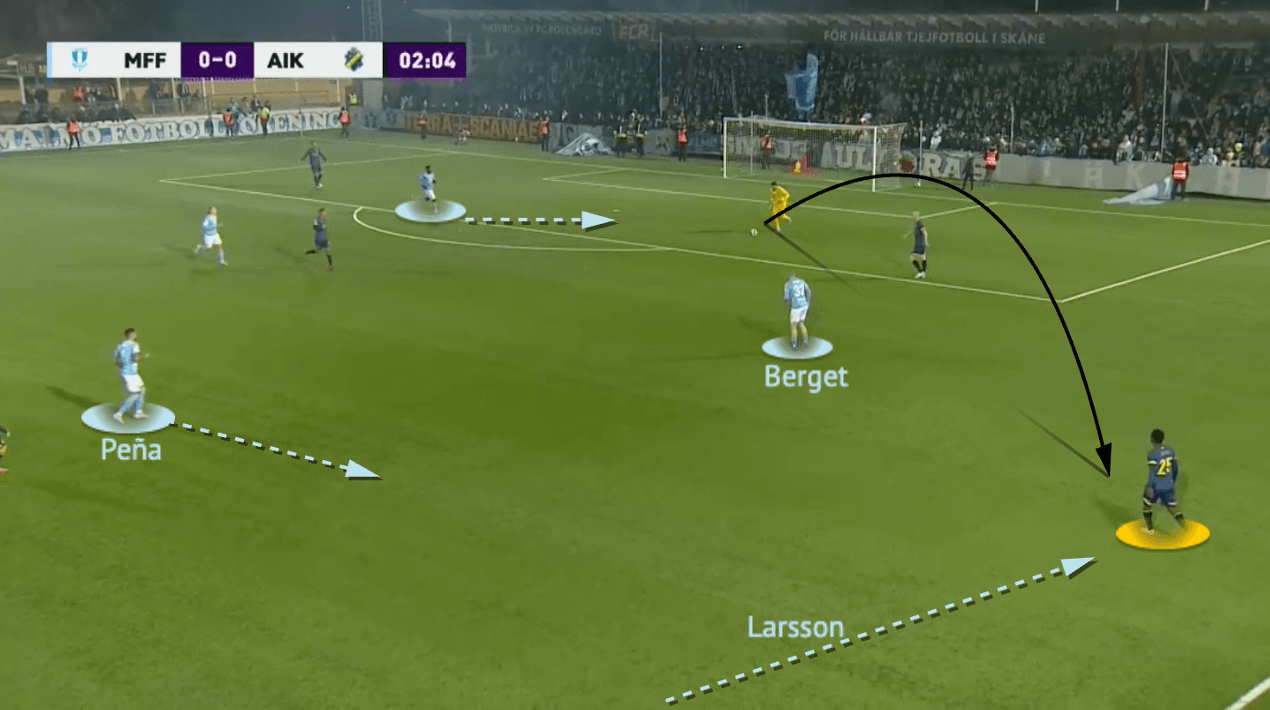
Malmö were very good at closing the opponents in one or two vertical zones, then, caged them and pressed them aggressively. But how could they do it?
Firstly, their players were never afraid of jumping out to press, the winger, the midfielders, would all be keen to press very high. The Malmö wingers were mostly pressing the centre-back on the inside to force the opponent play, sometimes the opponents could be clever, and lofted the ball to the full-back out wide as shown here.
But then, Malmö full-back, E. Larsson would jump on to press the receiver so it was not a problem at all.

When Malmö were able to net the opponents, it would be a terrible situation for the attacking side. They were also happy to commit all three midfielders to press the opponents to close them down, Miloš wanted to make sure in the vertical zone(s) beside the ball was closed, and the opponent could not play short passes easily there. It was a 5v4 in this example and Malmö had one more man than the opponent.
Here, Peña, Nanasi, and Rakip, were all involved in the high press, they cut the false-9 (Stefanelli), the 6 (Bilal Hussein). Also, Peña was going for the centre-back, so Berget could engage the left-back on the touchline.
The striker of Malmö must contribute without the ball as well, as we always see Kiese Thelin and Abubakari closing the passing lane to the centre with their body angle, including in this example. It was very difficult to play here…
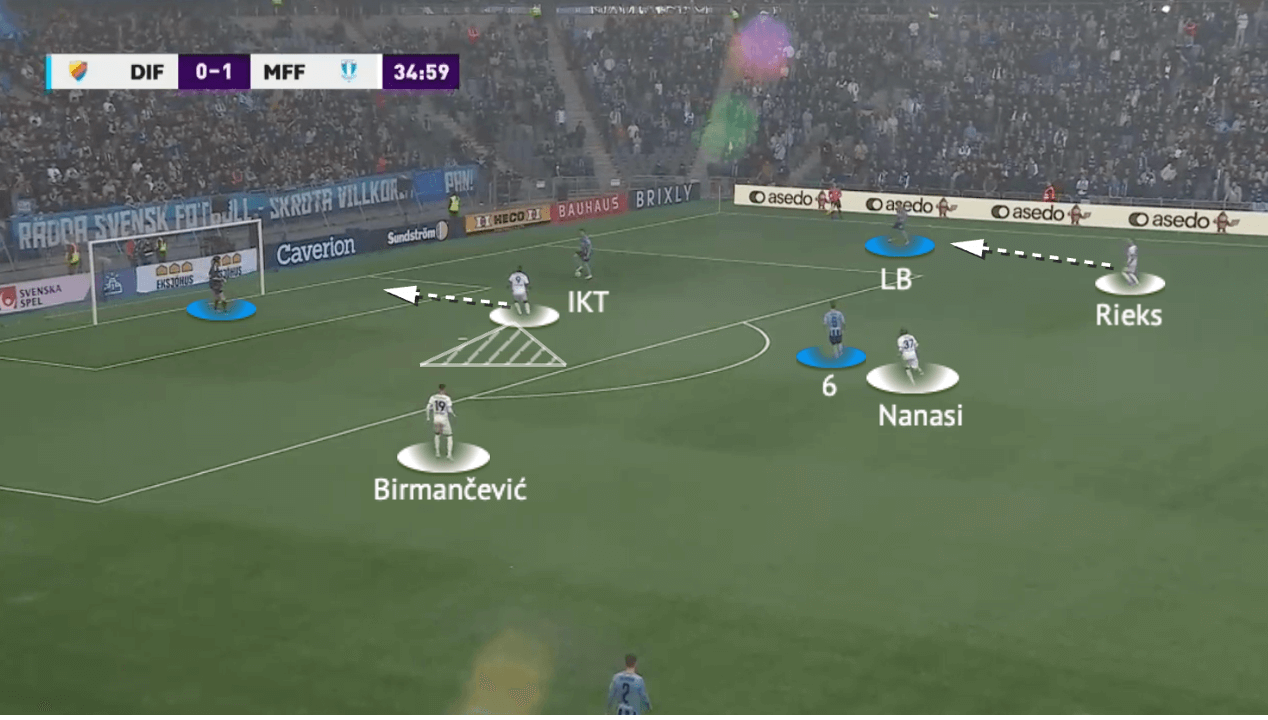
Against Djurgården, Malmö spent the second half deep, but they also pressed the opponent high in the first half, with a good sense to close the centre as well. Here, Nanasi jumped out to make sure Rasmus Schüller (6) was not free, while Søren Rieks was closing the left-back. Kiese Thelin, as usual, tried to block the passing lane in the centre. When Hjalmar Ekdal went back to Jacob Widell Zetterström, Kiese Thelin would chase to make sure Djurgården would kick the ball away.
Of course, in this setup, the Djurgården right-back on the other side could be free as Piotr Johansson was there, but if there was a diagonal switch, if Birmančević could not intercept, Olsson would definitely jump out to press.
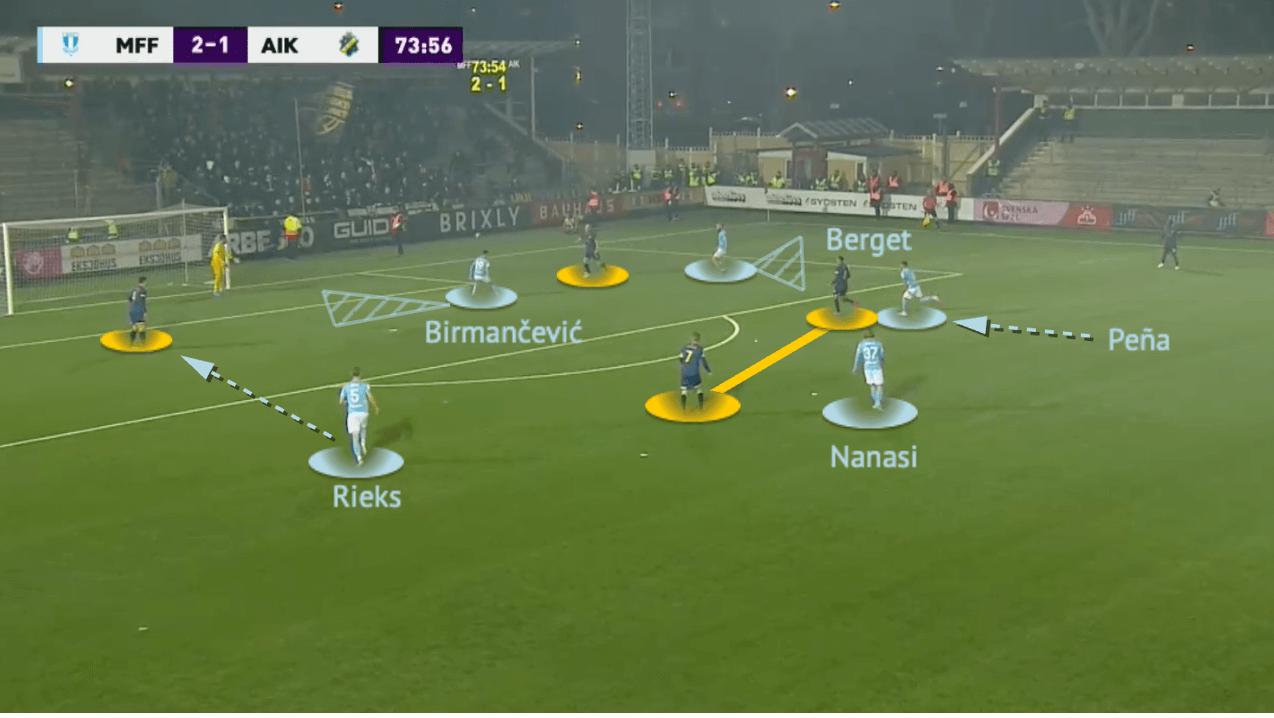
In the last example, the high press of Malmö was also aggressive, again, it was a 5v4 in the centre if we only counted the outfield players. They just needed to close the vertical zones beside the ball, so it is the entire centre.
On this occasion, Birmančević was the striker, and he just blocked the passing lane between centre-backs, forcing the pass back to Kristoffer Nordfelt, then pressed him to force the long kick. Also, Rieks would be going for the centre-back if Nordfelt could play that pass to Sotirios Papagiannopoulos under pressure – they cannot let AIK go away with that.
Both AIK midfielders were closed as Peña and Nanasi stepped up high, as usual. All options were closed and Malmö forced the opponents to play, this was how the high pressing worked if they did not win the ball back in higher areas.
Conclusion
Miloš is one of the emerging coaches in Scandi football recently, he stepped up from club to club very quickly. Just within four years, he went from Mjällby, to Hammarby, and now Malmö – one of the biggest jobs in Scandi football. Given the success of Di blåe already had, it would not be easy, but Miloš also had strong reinforcements such as Kiese Thelin, and Dennis Hadžikadunić backed to the team, there were a lot to expect from this side.





Comments